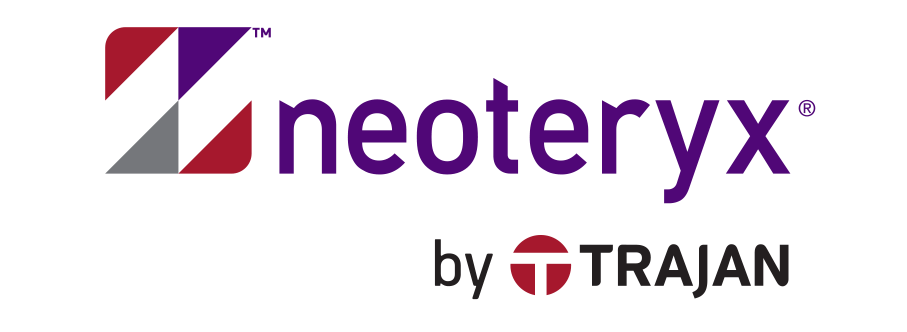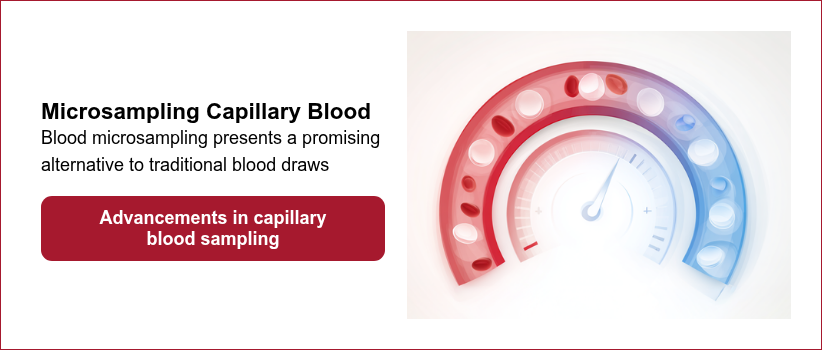Share this
blood microsampling: what It is, how it works, and when to use it
by Neoteryx Microsampling on Apr 20, 2017 5:51:00 AM
/full-tips-universal-anywhere-office-3-1.jpeg?width=820&height=513&name=full-tips-universal-anywhere-office-3-1.jpeg)
What you’ll learn
- What microsampling is and how it differs from venipuncture and DBS
- How capillary sampling works (volumes, devices, drying, analysis)
- Benefits, limitations, and technical considerations (stability, hematocrit, extraction)
- Where microsampling is used today (clinical research, TDM, public health, at-home testing)
- How labs process dried microsamples
What is Microsampling?
Microsampling involves collecting a very small volume of blood (often 10–30 µL; ≤50 µL by convention) from a capillary puncture (finger-stick, heel-stick, or alternative sites). The drop of blood is absorbed onto a fixed-volume collection device or applied to a card, dries at room temperature, and is later eluted and analyzed in the lab.
Fixed volume collection offers a modern alternative to traditional venipuncture and hematocrit prone dried blood spot (DBS) sampling methods.
Further, conventional blood sample obtained through venipuncture can range from 5 to 10 mL, making it 500 to 1,000 times larger than a microsample. Venipuncture also requires trained staff, and cold-chain logistics when shipped.
But Microsampling is minimally invasive, only requires low-volume collection and can be used for remote collection—supporting decentralized trials, longitudinal sampling, and improved participant experience.
Microsampling vs. Traditional Venipuncture and DBS

- Venipuncture (wet blood):
- Pros: long-established workflows; broad analytical coverage.
- Cons: larger volumes, needles, trained phlebotomists, cold-chain shipping, higher logistics cost; participant burden (especially pediatrics, frequent monitoring, needle anxiety).
- Traditional DBS (filter paper):
- Pros: ambient drying; simpler shipping/storage.
- Cons: hematocrit bias and spot inhomogeneity can affect quantitation; punching introduces potential carryover; more labor-intensive extraction.
- Modern microsampling (fixed-volume devices):
- Pros: precise, volumetric collection (independent of drop size); ambient drying; supports remote/home workflows; compatible with automation in many labs.
- Cons: small sample volume imposes assay selection/trade-offs; each lab must validate extraction and methods for targeted analytes.
How Microsampling Works: A Quick Overview
- Collection – A sterile lancet produces a capillary drop (typically 5–30 µL). A fixed-volume microsampling device absorbs a preset volume; the first drop is discarded to reduce contamination.
- Drying & storage – The device dries at ambient conditions in a protective cartridge or sleeve; no cold chain is typically required.
- Transport – Dried samples are packed and mailed to the lab, often as nonbiohazardous when compliant with applicable guidelines.
- Analysis – The lab elutes the dried sample (buffer/method optimized per analyte) and runs the intended assays on standard or automated instrumentation.
Capillary Blood Self-Collection Video: A Step by Step How To
Capillary blood: what’s different?
Capillary blood is a mixture of arterial and venous blood at the tissue exchange interface. Relative to venous plasma, capillary measures may show:
- Closer alignment with arterial values for pH and gases
- Slightly higher glucose, and differences in hematocrit/hemoglobin
- Modest shifts in electrolytes
For many assays, equivalence can be established via method validation. Always confirm correlation and bias for your analyte and method before clinical or research adoption.
Technical Challenges & Considerations
-
Sample Stability: Dried microsamples can remain stable for days or weeks at room temperature, but environmental factors may still affect certain analytes.
-
Hematocrit (HCT) Bias: Traditional DBS spot formation and analyte distribution can vary with HCT. Volumetric devices are designed to mitigate this by absorbing a fixed volume independent of drop size; nevertheless, labs should verify performance across expected HCT ranges.
-
Extraction Efficiency: Recovery depends on analyte chemistry (e.g., lipophilicity, protein binding) and matrix. Optimize extraction buffers/times per analyte.
- Assay suitability & LLOQ: Small volumes mean you must ensure sensitivity (LLOQ) is sufficient. Consider concentration steps or high-sensitivity platforms where needed.
-
User Technique: Standardize site warming, cleaning (often soap & water is preferred to alcohol for comfort/flow), discard first drop, avoid milking, and ensure correct drying/packaging.
Key Benefits of Microsampling Blood
- Minimally invasive & patient-friendly – Tiny punctures vs large-bore needles; useful for pediatrics, needle-anxious populations, geriatrics, and frequent monitoring.
- Remote & decentralized – At-home collection supports telehealth, decentralized clinical trials, and population studies.
- Lower logistics costs – Ambient drying reduces cold-chain and biohazard shipping costs; simpler packaging.
- Longitudinal feasibility – Easier repeat sampling at clinically relevant timepoints.
- Ethical advantages – Low-volume sampling facilitates pediatric research and supports reduction/refinement in preclinical animal work.
- Data Quality – Fixed-volume tips reduce variability, potentially improving analytical outcomes.
Use Cases for Microsampling Blood
-
Clinical Trials – Decentralized, patient-friendly sampling that may improve retention.
-
Therapeutic Drug Monitoring (TDM) – More frequent, lower-burden monitoring without venipuncture.
-
Pediatrics & Special Populations – Minimal sample volumes for vulnerable groups.
-
Population Health & Remote Studies – Enables data collection outside clinical settings.
-
Preclinical & Veterinary Research – As part of an international initiative aimed at improving the treatment of animals during medical screening, capillary microsampling was developed to address the 3Rs: Reduction, Replacement, and Refinement. This approach seeks to eliminate unnecessary harm to laboratory animals. The benefits of capillary microsampling extend beyond this goal, as it effectively reduces animal usage while supporting the principles of the 3Rs.
How Labs Process Dried Microsamples (overview)
- Receipt & logging – Verify identifiers; assess dryness/integrity.
- Elution – Place the device tip/segment in validated extraction buffer; agitate/incubate per SOP.
- Cleanup (as needed) – Protein precipitation, SPE, or dilution—per analyte/method.
- Quant/qual – LC–MS/MS, GC–MS, immunoassay, enzymatic, or molecular platforms as validated.
- QA/QC – Include matrix-matched calibrators/QCs, HCT-spread challenges, and incurred sample reanalysis as appropriate.
Finger-stick Blood Testing is Changing Healthcare
The rapid expansion of telemedicine and remote care pathways has accelerated adoption of finger-stick sampling. Labs now commonly ship at-home kits (including collection devices, lancets, and instructions). Participants collect, dry, and mail samples for analysis—supporting continuous programs like chronic disease monitoring and longitudinal serology.
Are all lancets the same? (comfort & performance)
- Standard exposed-blade – Works but can be more painful; single-use only.
- Safety (spring-loaded, auto-retract) – More hygienic and user-friendly—blade not visible before/after use.
- Vacuum-assisted – Shallower penetration with negative pressure to draw blood; enables alternative sites beyond fingertips.
- Laser (legacy) – Historically more painful; rarely used today.
Comfort tips: wash with soap and water (alcohol can constrict/dry skin), prick the side of the fingertip, select appropriate gauge/depth, discard the first drop, and avoid milking.
Next Steps
Microsampling offers a reliable, patient-friendly, and operationally efficient alternative to traditional blood collection. With proper validation, attention to hematocrit and extraction, and good collection technique, it can expand access, reduce costs, and support modern research and care. Contact us to explore how our devices and expertise can help you adopt microsampling technology effectively. Or to learn more click here.

Share this
- Microsampling (206)
- Research, Remote Research (119)
- Venipuncture Alternative (105)
- Clinical Trials, Clinical Research (83)
- Mitra® Device (73)
- Therapeutic Drug Monitoring, TDM (51)
- Dried Blood Spot, DBS (39)
- Biomonitoring, Health, Wellness (30)
- Infectious Disease, Vaccines, COVID-19 (24)
- Blood Microsampling, Serology (23)
- Omics, Multi-Omics (21)
- Decentralized Clinical Trial (DCT) (20)
- Specimen Collection (18)
- Toxicology, Doping, Drug/Alcohol Monitoring, PEth (17)
- Skin Microsampling, Microbiopsy (14)
- hemaPEN® Device (13)
- Preclinical Research, Animal Studies (12)
- Pharmaceuticals, Drug Development (9)
- Harpera Device (7)
- Industry News, Microsampling News (5)
- Antibodies, MAbs (3)
- Company Press Release, Product Press Release (3)
- Environmental Toxins, Exposures (1)
- July 2025 (1)
- May 2025 (1)
- April 2025 (2)
- December 2024 (2)
- November 2024 (1)
- October 2024 (3)
- September 2024 (1)
- June 2024 (1)
- May 2024 (1)
- April 2024 (4)
- March 2024 (1)
- February 2024 (2)
- January 2024 (4)
- December 2023 (3)
- November 2023 (3)
- October 2023 (3)
- September 2023 (3)
- July 2023 (3)
- June 2023 (2)
- April 2023 (2)
- March 2023 (2)
- February 2023 (2)
- January 2023 (3)
- December 2022 (2)
- November 2022 (3)
- October 2022 (4)
- September 2022 (3)
- August 2022 (5)
- July 2022 (2)
- June 2022 (2)
- May 2022 (4)
- April 2022 (3)
- March 2022 (3)
- February 2022 (4)
- January 2022 (5)
- December 2021 (3)
- November 2021 (5)
- October 2021 (3)
- September 2021 (3)
- August 2021 (4)
- July 2021 (4)
- June 2021 (4)
- May 2021 (4)
- April 2021 (3)
- March 2021 (5)
- February 2021 (4)
- January 2021 (4)
- December 2020 (3)
- November 2020 (5)
- October 2020 (4)
- September 2020 (3)
- August 2020 (3)
- July 2020 (6)
- June 2020 (4)
- May 2020 (4)
- April 2020 (3)
- March 2020 (6)
- February 2020 (3)
- January 2020 (4)
- December 2019 (5)
- November 2019 (4)
- October 2019 (2)
- September 2019 (4)
- August 2019 (4)
- July 2019 (3)
- June 2019 (7)
- May 2019 (6)
- April 2019 (5)
- March 2019 (6)
- February 2019 (5)
- January 2019 (8)
- December 2018 (3)
- November 2018 (4)
- October 2018 (7)
- September 2018 (6)
- August 2018 (5)
- July 2018 (8)
- June 2018 (6)
- May 2018 (5)
- April 2018 (6)
- March 2018 (4)
- February 2018 (6)
- January 2018 (4)
- December 2017 (2)
- November 2017 (3)
- October 2017 (2)
- September 2017 (4)
- August 2017 (2)
- July 2017 (4)
- June 2017 (5)
- May 2017 (6)
- April 2017 (6)
- March 2017 (5)
- February 2017 (4)
- January 2017 (1)
- July 2016 (3)
- May 2016 (1)
- April 2016 (2)



Comments (6)